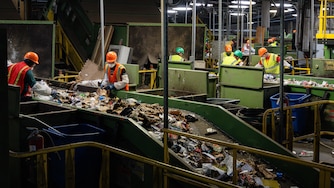The Francis Scott Key Bridge collapsed into the Patapsco River on March 26 after a cargo ship leaving the Port of Baltimore struck a key support holding up the bridge.
Four bodies have been recovered from the wreckage and two people remain unaccounted for, though they are presumed dead. Officials have shifted to a salvage operation as they continue their investigations and look to clear the metal, concrete and other debris cutting off the city’s port.
Here are key things you need to know about the bridge collapse and its impact.
Why did the Key Bridge collapse?
The ship that hit the Key Bridge, the Dali, is a neo-Panamax ship that can carry 116,000 deadweight tons. When it hit the bridge, it was traveling at about 9.2 miles per hour. One expert calculated it would have hit the bridge with over a million newtons of force, a crash that would be difficult for any structure to withstand.
The bridge was also “fracture critical,” meaning if any one portion sustained enough damage, the entire structure would collapse.
Why did a cargo ship hit the Key Bridge?
At 1:25 a.m. on March 26, as the cargo ship Dali was leaving the port, the entire ship went dark. The ship lost radar, propulsion, engine power and more all at once, according to the executive director and general counsel for The American Pilots’ Association.
Read More
The ship’s pilot had the anchor dropped and “did everything he could to slow the ship,” but without a functioning engine there was little chance of averting disaster.
Why the engine stopped working has not been determined.
Who is investigating the crash?
The National Transportation Safety Board is investigating the crash and is focused on the Dali’s electrical systems.
Federal authorities recently opened a criminal probe and the FBI raided the ship. The investigation is looking at, in part, whether the ship’s crew knew the Dali had electrical or mechanical issues before it left Baltimore.
How many people died or were injured?
Six people who were part of a construction crew working on the bridge when it collapsed are presumed dead. So far, four bodies have been recovered and two more are believed to be trapped under the wreckage.
One person was hospitalized after the collapse but has since been released, and another person refused medical treatment after the collapse.

Who was on the bridge?
A construction crew from Brawner Builders, a Baltimore County-based construction firm, were repairing potholes on the bridge at the time of the collapse. Maryland Transportation Authority Police officers managed to stop traffic from crossing the bridge with less than a minute to spare before it collapsed.
Did anyone try to warn the construction crew?
Maryland Gov. Wes Moore has said “early indications” suggest officials tried to alert the crew on the bridge, but it’s unclear what signals would have reached them. Attorneys for a survivor of the collapse said the work crew was not warned, according to The Baltimore Sun.
What is clear, from police dispatch audio, is that officers who had stopped vehicle traffic intended to get the crew off the bridge but ran out of time before the collapse.
What do we know about the victims?
We know the six men were all Latino immigrants ranging from ages 26-49, who have been described as humble, hardworking and devoted. Some lived in Southeast Baltimore and some lived in Dundalk.

Are there ways to help the families?
There are local nonprofits coordinating assistance to the families. Some local breweries and other businesses have also hosted fundraisers. Click here to learn more.
Is there a map of what the crash looked like?
The Banner has multiple maps and visualizations that show how the crash happened. One on this page shows the ship’s short route to the bridge, while this one shows a more detailed view of the crash.
What is the impact on the port?
Thousands of port workers are facing a bleak economic future — no ships are able to enter the port until the debris is cleared. Every dock except one at Tradepoint Atlantic is cut off.
While the bridge collapse could impact the local economy for years to come, experts say the global supply chain is pivoting quickly to minimize disruptions.
The city approved $1 million in relief funding for workers affected by the collapse, too.
What do we know about the cargo ship Dali?
The Dali is a 984-foot long cargo ship, longer than two Commerce Place towers stacked together. It’s flagged out of Singapore. It had 22 crew members on board, including two pilots, who have all been accounted for, according to a statement from Synergy Marine Group.
A United States Coast Guard official said during a White House press briefing that the ship had 4,700 cargo containers on board, 56 of which contain hazardous materials and two that are missing overboard. Initially, officials said there was no leak from the containers on board or the ship itself. On Wednesday night, officials with the National Transportation Safety Board said they observed a sheen on the water.
Is the waterway open?
Two temporary channels are open, allowing some vessels to come in and out of the Port of Baltimore. The Army Corps of Engineers has set an aggressive timeline to get a larger commercial channel open by the end of April, and to have the full-size channel, currently blocked by the Dali and wreckage, open by the end of May.
Was the key bridge collapse a cyberattack or terrorism?
Are there images of the wreckage?
Yes. A Baltimore Banner photojournalist was able to get on a boat and capture images that show close-up details from the collapse. Click here to see more.
Is there video of the Key Bridge crash?
Yes, there are multiple videos that show the crash. The videos show the lights on the ship switching on and off and a plume of black smoke coming from it. The video shows the vessel striking the support pylon and the bridge collapsing just seconds after.
Key Bridge collapse
What is the impact on traffic?
The Francis Scott Key Bridge provided one of three routes across the harbor for drivers in Baltimore. Drivers will instead have to reroute to the I-895 or the I-95 tunnels.
Vehicles carrying hazardous materials are not allowed in the tunnels, and so will have to reroute around the entire I-695. The Maryland Transportation Authority recommends avoiding the I-695 southeast corridor as much as possible. The outer loop of the Beltway is closed at MD 10 (exit 2) and the inner loop is closed at MD 157/Peninsula Expressway (exit 43).
So far, the state has seen approximately 15,000 additional vehicles a day using the Fort McHenry Tunnel and about 7,000 more traveling through the Baltimore Harbor Tunnel.
Drones flying within 3 miles of the Key Bridge and 1,500 feet above ground have been temporarily prohibited by the Federal Aviation Administration so that they won’t interfere with the salvage efforts.
Is the Chesapeake Bay Bridge safe?
The Bay Bridge was found to be structurally sound, but it has been costly to maintain. It is also a “fracture critical” bridge, like the Key Bridge was, meaning damage to part of the bridge could cause the entire thing to collapse.
“With the Key Bridge incident in mind, there has been a renewed focus on pier protection at the Maryland Transportation Authority’s ... signature bridges, including the Bay Bridge,” Maryland Secretary of Transportation Paul J. Wiedefeld said.
What runs under the river near the Key Bridge collapse?
There’s a BGE underwater natural gas pipeline that runs in the area of the Key Bridge collapse, which according to the utility company has not been damaged during cleanup.
BGE has been coordinating with the Unified Command and isolated a section of the pipeline as a safety measure. There aren’t any safety concerns at this time, and customers haven’t been affected.
The city also has a water main that runs under the Patapsco River, according to the Maryland Department of the Environment. The 72-inch water main runs parallel to the Key Bridge and once serviced Anne Arundel County, according to the Baltimore City Department of Public Works. The main will not impact water service to any customers or hydrants.
How old was the Key Bridge?
Construction on the bridge finished in March 1977, and it cost more than $60 million to build, according to the MDTA.
The Francis Scott Key Bridge had the third-longest span of any truss bridge in the world before its collapse and was the longest bridge in the Baltimore area.
It opened in March 1977 and was the last part of the Baltimore Beltway, according to the MDTA. It had four lanes for traffic and crossed the Patapsco River.
The bridge was in “fair condition” prior to the disaster, according to a copy of a summary report from the National Bridge Inventory.

Would a different design have helped?
It’s hard to say. Some experts think having huge, concrete “dolphins” in the water around the Key Bridge’s support structures could have diverted the ship and prevent the direct collision.
“I don’t know how a bridge possibly could withstand the forces that were at play when this vessel” hit the bridge, Transportation Secretary Pete Buttigieg said during a White House press briefing.
How do I report debris?
If you see debris that you think is associated with the Key Bridge collapse, officials are urging that you not touch it for safety reasons.
Instead, there’s a hotline to call for reporting debris: 410-205-6625.
What happens next?
President Joe Biden said he wants the federal government to pay the entire cost of rebuilding the bridge. Already, $60 million in emergency relief funds have been approved for the immediate necessary work surrounding the collapse. Sen. Chris Van Hollen said the state would be eligible for more emergency relief funds to rebuild the Key Bridge.
Pieces of the bridge are being cut into sections and hauled out of the water by four large cranes as the Army Corps of Engineers works to open the full-size channel by the end of May. One of the cranes can lift 1,000 tons. The bridge remnants that are sitting on top of the ship weigh about 3,000 to 4,000 tons.
“By investing this time now in the engineering, we’re going to be able to move faster later. I know right now everyone wants to see things move. You need to trust that behind the scenes it’s moving,” said Col. Estee S. Pinchasin, commander of the U.S. Army Corps of Engineers, Baltimore District.
Baltimore Banner reporter Jasmine Vaughn-Hall contributed to this article.
Correction: This story has been updated to correct the length of the Dali ship and the number of cargo containers it had on board.




Comments
Welcome to The Banner's subscriber-only commenting community. Please review our community guidelines.